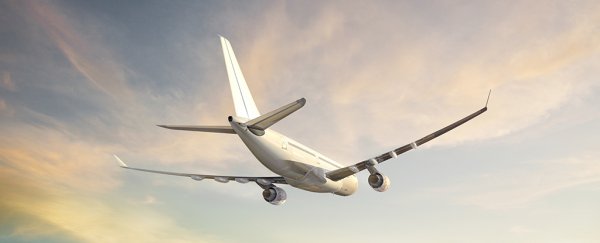Modern-day aircraft already make use of jet streams to save time and fuel, but a new study shows that by being a bit smarter about how they ride these winds, transatlantic flights could be using up to 16 percent less fuel – and pumping out much less CO2 as a result.
The key is flexibility, the researchers say: allowing planes to vary their flight paths more often and to a greater extent depending on how the jet stream is moving on any particular day. Upcoming advances in satellite and tracking technology mean this can be done without adding any more risk to journeys.
Millions of kilograms of CO2 emissions could be saved every year, if the airlines and the air navigation service providers on both sides of the Atlantic agreed to adopt the modified system – and the changes would be inexpensive and quick to implement too.
"Current transatlantic flight paths mean aircraft are burning more fuel and emitting more carbon dioxide than they need to," says mathematics PhD student Cathie Wells, from the University of Reading in the UK.
"Although winds are taken into account to some degree when planning routes, considerations such as reducing the total cost of operating the flight are currently given a higher priority than minimising the fuel burn and pollution."
To crunch the necessary numbers in terms of fuel savings, the team looked at around 35,000 flights between London and New York, covering the dates 1 December 2019 to 29 February 2020 and involving nearly a million passengers in total.
While the maximum fuel savings on a flight was 16 percent, the average was much lower: 1.7 percent for flights west to New York, and 2.5 percent for flights east to London. Those differences can quickly add up though, with the researchers estimating that around 6.7 million kilograms (14.7 million pounds) of CO2 emissions could've been saved over the period of time looked at in the study.
With aviation currently responsible for around 2.4 percent of human-caused carbon emissions – a figure that's growing by the way – the need to find ways to cut down on the production of this greenhouse gases is an urgent one.
 Some of the routes currently used by transatlantic flights. (Wells et al, Environmental Research Letters 2021)
Some of the routes currently used by transatlantic flights. (Wells et al, Environmental Research Letters 2021)
"Upgrading to more efficient aircraft or switching to biofuels or batteries could lower emissions significantly, but will be costly and may take decades to achieve," says atmospheric scientist Paul Williams, from the University of Reading.
"Simple tweaks to flight paths are far cheaper and can offer benefits immediately. This is important, because lower emissions from aviation are urgently needed to reduce the future impacts of climate change."
If airlines are prepared to put saving fuel above cutting costs when it comes to riding the jet stream, the low Earth orbit satellite technology needed to make this idea a reality is already in the testing phase.
Up until now, the large volume of transatlantic air traffic and spotty radar coverage in the middle of the ocean has constrained what planes can do in terms of varying their routes – but that excuse isn't going to be valid for much longer.
While this new analysis does simplify some of the modelling when it comes to tracking long haul flights over the Atlantic, the research team is planning a more detailed look in the future at how this approach might work – just one of several ideas about reducing aviation emissions in the years to come.
"In future studies we plan to investigate the design of optimal routes that are robust under uncertain weather conditions," write the researchers in their published paper.
"It would also be useful for airlines to be able to have the flexibility to change horizontal route, altitude and airspeed in order to make flight times more uniform, whilst also keeping fuel burn and thus emissions to a minimum."
The research has been published in Environmental Research Letters.
